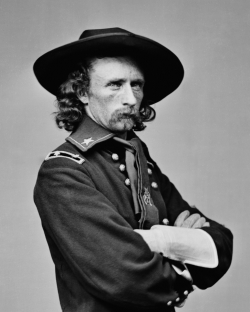Custer's Last Stand

It was one hundred and forty years ago, on the morning of June 25, 1876, when Lieutenant Colonel George A. Custer and the 7th Cavalry charged into battle against Lakota Sioux and Northern Cheyenne Indians.
In 1868 General William Tecumseh Sherman and Chief Red Cloud had signed a treaty. The Indians were to withdraw to a large reservation in the Black Hills of South Dakota. The place where they were to make their home and forever live in peace, was so vast that it was bounded with the Yellowstone on the north, the Missouri on the east, the North Platte on the south and the Big Horn mountains on the west.
The treaty had given the Sioux exclusive rights to the Black Hills, but when gold was later discovered in the area, white miners flocked to the territory, and despite everything that had been promised, the US government ordered the Indians away from the invading settlers.
By late 1875, the Sioux and Cheyenne Indians were outraged over the continued intrusions of whites into their sacred lands of the Black Hills, and defiantly left their reservations to join the great warrior, Sitting Bull, in Montana to fight for their lands.
On the morning of June 25, 1876, Custer's orders were to wait for reinforcements at the mouth of the Little Big Horn River before attacking the Indians, but a Sioux village was spotted, along with a nearby group of around forty warriors. He was impatient, and so ignoring his orders to wait, he decided to attack before the group could alert the main party, never realizing that the warriors in the village far outnumbered his own battalion.
He dispatched three columns to attack in coordinated fashion, to strike the village at the northern and southern ends simultaneously. Custer was to charge the village from the north, Reno from the south, and Benteen was to prevent their escape through the upper valley of the Little Big Horn River.
Chief Sitting Bull was ready for them...
The first two groups, led by Benteen and Reno were immediately forced to retreat to one side of the river, but Custer was not as lucky. Quickly encircled, Custer and his soldiers were killed in less than an hour.
It was the beginning of the end of the Indian Wars, and within hours of the battle, the large encampment on the Little Bighorn had broken up into smaller groups with many fleeing north, although there simply wasn't enough game and grass to sustain a large congregation of people and horses.
There have been several radio adaptations of the stories of the Battle of Little Big Horn, Custer, and Sitting Bull which you can listen to on RUSC. I have listed several of these below:-
Cavalcade of America - Songs of the American Indian
Frontier Fighters - Custer's Last Stand at Little Big Horn
Frontier Gentleman - Charlie Meeker
Gunsmoke - Custer
Have Gun Will Travel - Comanche
Lone Ranger - Rendezvous at Little Big Horn
Lone Ranger - Custer Rides With The Lone Ranger
You Are There - The Surrender of Sitting Bull
Happy listening my friends,
